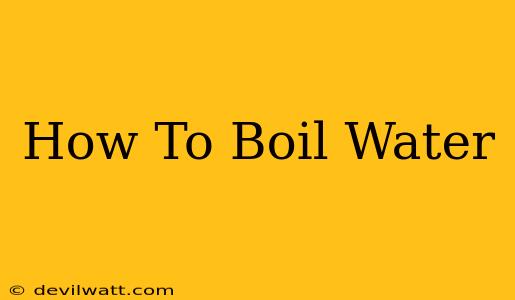Boiling water seems simple, right? But there's a right way and a wrong way to do it, especially if you're aiming for consistently perfect results for tea, pasta, or other cooking needs. This guide will walk you through the process, covering various methods and addressing common mistakes.
Choosing Your Vessel: The Right Pot for the Job
The type of pot you use significantly impacts how efficiently and safely you boil water.
The Best Pots for Boiling Water:
- Stainless Steel: Durable, heats evenly, and is easy to clean. A good all-around choice.
- Copper: Excellent heat conductor, boils water quickly, but requires more care and may be more expensive.
- Glass: Allows you to see the water level clearly, but can be fragile and may not heat as quickly.
- Non-stick: While convenient, avoid using non-stick pots for boiling water unless specifically designed for high heat.
Avoid: Using damaged pots with scratches or dents, as these can affect even heating and potentially create safety hazards.
The Boiling Process: Step-by-Step Instructions
Here's a simple, foolproof method for boiling water:
- Fill the pot: Add the desired amount of water to your chosen pot. Don't overfill; leave at least a few inches of space between the water level and the top of the pot to prevent spills.
- Place on the stovetop: Put the pot on a burner over medium-high heat. Avoid using high heat initially, as this can cause uneven heating and potentially burn the water.
- Watch for signs of boiling: You'll see small bubbles start to form along the bottom and sides of the pot. As the water heats, the bubbles will become more frequent and larger.
- Full boil: The water is boiling when it vigorously bubbles and steams constantly. At this point, you can reduce the heat to maintain a gentle boil, depending on your needs.
Common Mistakes to Avoid
- Overfilling the pot: This can lead to spills and potential burns.
- Using high heat initially: This can cause uneven heating and scorching.
- Leaving the pot unattended: Always monitor the pot while the water is heating to prevent boil-overs.
- Using the wrong type of pot: Choosing a pot that isn't suitable for boiling water can lead to inefficient heating or even damage the pot.
Beyond the Basics: Tips and Tricks
- For faster boiling: Use a lid to trap heat, but remove it towards the end of the process to prevent boil-overs.
- For perfectly clear water: Use filtered water to avoid sediment or cloudiness.
- Temperature control: Once boiling, adjusting the heat allows you to maintain a gentle simmer for delicate foods or a rolling boil for pasta.
Conclusion: Mastering the Art of Boiling Water
Boiling water might seem fundamental, but understanding the nuances of the process ensures you get consistently excellent results every time. By following these steps and avoiding common mistakes, you'll be a boiling water expert in no time! Now go forth and boil!

